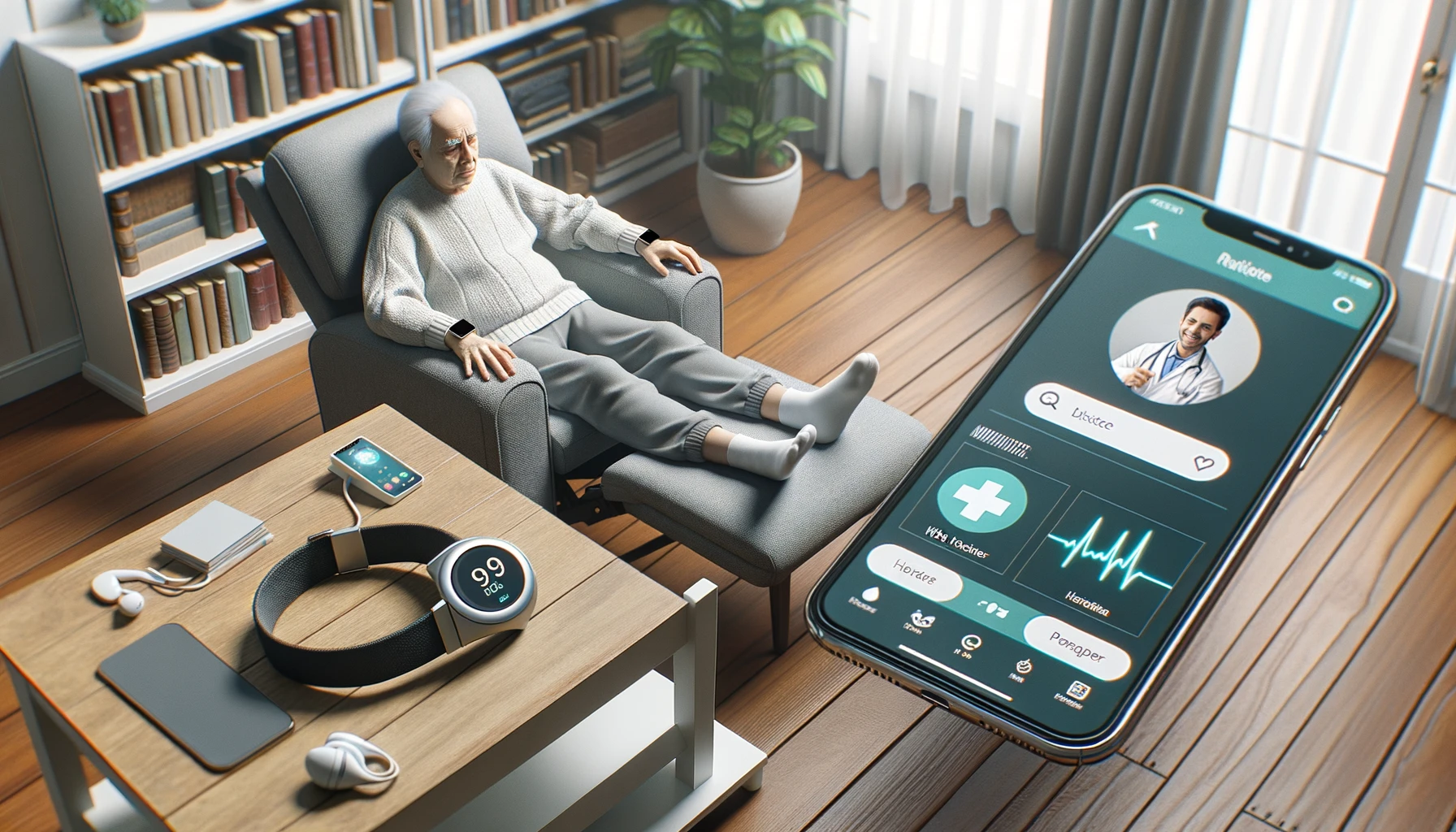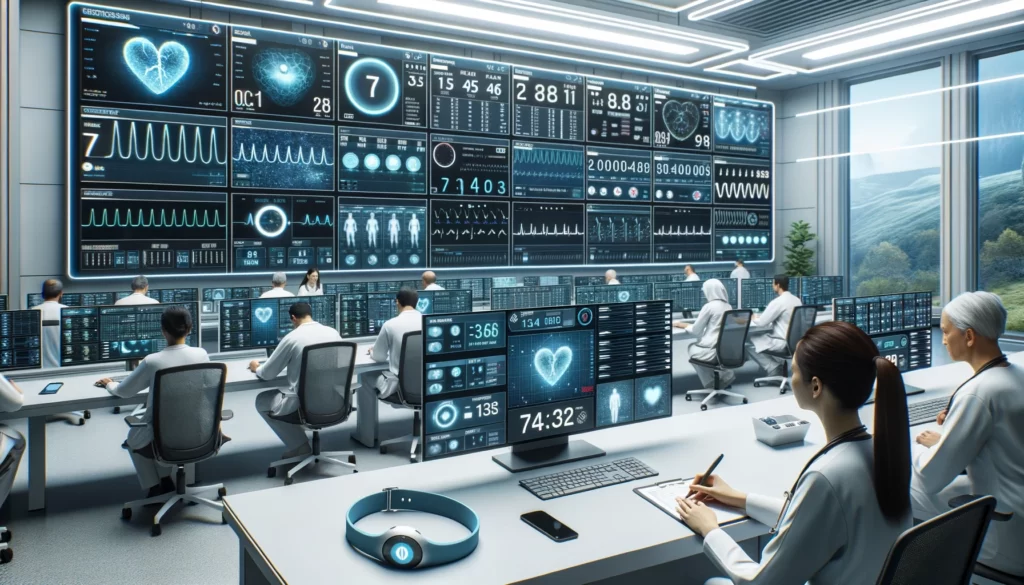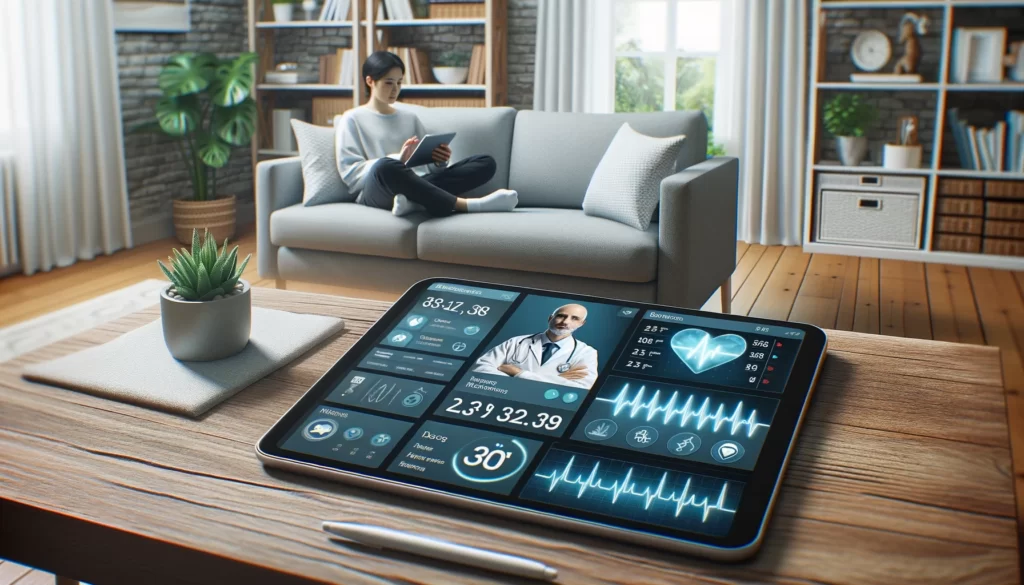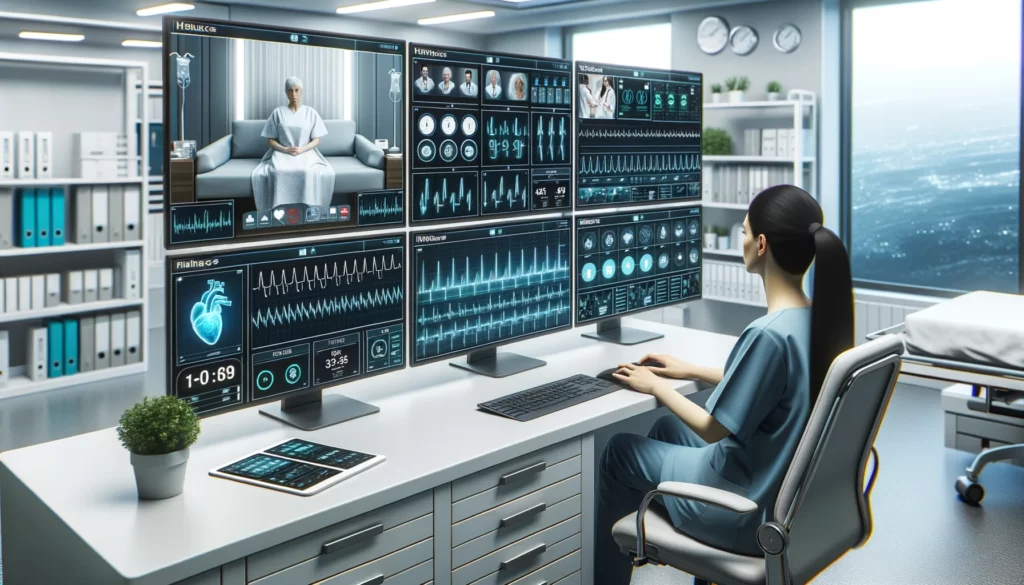
Remote patient monitoring brings numerous benefits to patients, empowering them to take control of their health and well-being.
Key Takeaways:
- Remote patient monitoring improves data-driven clinical decision-making.
- It helps patients improve self-management and care plan adherence.
- Remote monitoring reduces the cost of care for payors and providers.
- It boosts net patient revenue and reduces patient expenses.
- Remote patient monitoring improves access to care and patient engagement.
Enhance Patient Care with Remote Patient Monitoring
Remote patient monitoring technology enables healthcare providers to deliver enhanced patient care through real-time monitoring and personalized support. By remotely monitoring patients’ vital signs, symptoms, and overall health, healthcare providers can gather valuable data outside of traditional healthcare settings and make data-driven clinical decisions.
With remote patient monitoring, healthcare providers can closely track patients’ health conditions and intervene promptly when necessary. This proactive approach allows for early detection of potential health complications and enables timely adjustments to care plans. By leveraging real-time data, providers can provide personalized care tailored to each patient’s specific needs and preferences.
Moreover, remote patient monitoring empowers patients to actively participate in their own care. Patients can access their health data and receive real-time feedback, helping them better understand their conditions and make informed decisions about their health. This increased involvement enhances patient engagement and improves adherence to care plans, ultimately leading to improved patient outcomes.
Additionally, remote patient monitoring offers the convenience and comfort of receiving healthcare services from the comfort of one’s home. Patients no longer need to travel to healthcare facilities for routine check-ups or monitoring. This not only saves time and reduces expenses but also reduces the risk of exposure to infectious diseases and hospital-acquired infections.
| Benefits of Remote Patient Monitoring for Enhanced Patient Care |
|---|
| Real-time monitoring of vital signs and symptoms |
| Personalized care based on patient-specific data |
| Proactive intervention and timely adjustments to care plans |
| Increased patient engagement and adherence to care plans |
| Convenience, comfort, and reduced expenses for patients |
Reduce Hospital Visits with Remote Patient Monitoring
With remote patient monitoring, patients can experience fewer hospital visits and reduce their healthcare expenses while still receiving quality care. This innovative healthcare delivery method allows healthcare providers to remotely monitor patients’ health conditions and gather valuable data outside of traditional healthcare settings. By doing so, it increases access to virtual care and enhances patient involvement in their own care.
One of the key benefits of remote patient monitoring is the reduction in hospital visits. With the ability to monitor patients from the comfort of their own homes, healthcare providers can identify and address potential issues before they escalate, ultimately preventing the need for hospitalization. This proactive approach to healthcare management not only improves patient outcomes but also reduces the strain on hospitals, leading to cost savings for both patients and healthcare providers.
Furthermore, remote patient monitoring offers convenience and flexibility for patients. Instead of having to travel to hospitals or clinics for routine check-ups, patients can use remote monitoring devices to track their vital signs, symptoms, and medication adherence. This not only saves them time and money but also empowers them to take an active role in managing their own health. Patients can also benefit from personalized support and guidance, as healthcare providers are able to review their data in real time and provide timely interventions or adjustments to their care plans.
| Benefits of Remote Patient Monitoring: |
|---|
| – Reduces hospital visits and readmissions |
| – Lowers healthcare costs for patients and providers |
| – Improves patient outcomes and self-management |
| – Enhances patient engagement and satisfaction |
| – Optimizes clinical staff efficiency and addresses shortages |
| – Expands referral opportunities and improves retention |
| – Strengthens the clinician-patient relationship |
Remote patient monitoring brings immense benefits to patients, providers, and the healthcare system as a whole. By reducing hospital visits, lowering healthcare costs, and improving patient outcomes, remote monitoring not only enhances the quality of care but also ensures that patients receive the attention they need while minimizing the burden on healthcare facilities.
It empowers patients to actively participate in their own care, leading to increased engagement and satisfaction. With the growing need for efficient and cost-effective healthcare solutions, remote patient monitoring is a game-changer that enables patients to live healthier lives and providers to deliver comprehensive care.

Improve Health Outcomes with Real-Time Data Monitoring
Real-time data monitoring provided by remote patient monitoring significantly improves health outcomes by enabling proactive care and timely interventions. With the ability to remotely collect and analyze vital health information, healthcare providers can make data-driven clinical decisions and provide personalized care plans that address patients’ unique needs. This proactive approach helps identify potential health issues before they escalate, leading to better treatment outcomes and improved quality of life.
One of the key benefits of real-time data monitoring is the early detection of health complications. By continuously monitoring patients’ vital signs, such as blood pressure, heart rate, and blood glucose levels, providers can identify abnormalities and intervene promptly. This proactive approach helps prevent adverse events, reduces hospitalizations, and minimizes the overall cost of care for both patients and payors.
Additionally, real-time data monitoring empowers patients to actively participate in their own care, promoting self-management and adherence to care plans. Patients can access their health data through user-friendly platforms or mobile applications, enabling them to track their progress, receive educational resources, and communicate with their healthcare team.
This increased engagement fosters a sense of ownership and responsibility for their health, leading to better treatment outcomes and improved patient satisfaction.
| Benefits of Real-Time Data Monitoring: |
|---|
| Early detection of health complications |
| Reduced hospitalizations |
| Prompt interventions |
| Improved treatment outcomes |
| Patient empowerment and engagement |
Real-time data monitoring provided by remote patient monitoring technology offers significant benefits in improving health outcomes. By enabling proactive care, timely interventions, and patient engagement, it helps prevent complications, reduce hospitalizations, and enhance the overall quality of care.
The ability to monitor patients remotely and gather real-time data expands access to care, promotes effective self-management, and ultimately improves patients’ well-being.

Enhance Patient Engagement and Satisfaction
Remote patient monitoring enhances patient engagement and satisfaction by providing convenient and accessible healthcare services tailored to individual needs. With the implementation of remote monitoring technology, patients can actively participate in their own care from the comfort of their homes.
One of the key benefits of remote patient monitoring is the ability to collect real-time data, allowing healthcare providers to track patients’ health conditions more effectively. This data-driven approach enables personalized care plans and timely intervention, optimizing treatment outcomes and improving patient satisfaction.
Furthermore, remote patient monitoring enhances patient engagement through increased connectivity. Patients have the opportunity to communicate with their healthcare providers, ask questions, and seek guidance remotely. This level of connectivity fosters a sense of partnership between patients and clinicians, ensuring that patients feel heard and involved in their care decisions.
Benefits of Remote Patient Monitoring
In summary, remote patient monitoring offers several benefits that enhance patient engagement and satisfaction:
- Convenient and accessible healthcare services tailored to individual needs
- Real-time data collection for personalized care and timely intervention
- Increased connectivity between patients and healthcare providers
- Active participation in care decisions and improved patient satisfaction
By adopting remote patient monitoring, healthcare providers can revolutionize the way care is delivered, improving patient outcomes and fostering a positive patient experience. As technology continues to advance, remote monitoring will play an increasingly important role in the future of healthcare, providing patients with better access to care, enhanced engagement, and greater satisfaction.
| Benefits of Remote Patient Monitoring | Summary |
|---|---|
| Convenient and accessible healthcare services tailored to individual needs | Patients can receive care from the comfort of their homes while maintaining their daily routines. |
| Real-time data collection for personalized care and timely intervention | Healthcare providers can monitor patients’ health conditions in real-time, enabling proactive care and timely adjustments to treatment plans. |
| Increased connectivity between patients and healthcare providers | Patients have the opportunity to actively engage with their healthcare providers, fostering a sense of partnership and involvement in care decisions. |
| Active participation in care decisions and improved patient satisfaction | Patients feel empowered and satisfied when they are actively involved in their own care, leading to better treatment outcomes. |
Reduce Healthcare Costs and Readmissions
Remote patient monitoring offers cost-effective healthcare solutions that reduce overall healthcare costs and mitigate the need for hospital readmissions. By allowing healthcare providers to gather patient data outside of traditional healthcare settings, remote monitoring increases access to virtual care and enhances patient involvement in their own care. This proactive approach to healthcare management helps to identify potential issues early on and prevent complications that may lead to costly hospital stays or readmissions.
One of the key advantages of remote patient monitoring is its ability to reduce the total cost of care. By utilizing remote monitoring technology, healthcare providers can closely monitor patients’ health conditions, track vital signs, and identify any deviations from the established care plan. This real-time data enables healthcare professionals to intervene promptly, adjust medication dosages, or provide additional support to patients, thereby preventing the progression of a condition and avoiding expensive hospital visits.
Also, remote patient monitoring promotes efficient resource allocation and utilization, which leads to significant cost savings. By connecting patients with their healthcare providers remotely, unnecessary in-person appointments can be minimized, reducing both healthcare expenses and the burden on healthcare facilities. This not only saves time and money for patients but also helps to optimize the overall efficiency of the healthcare system.
| Benefits of Remote Patient Monitoring |
|---|
| Reduces healthcare costs |
| Minimizes the need for hospital readmissions |
| Improves patient outcomes |
| Enhances patient engagement and satisfaction |
| Optimizes clinical staff efficiency |
The implementation of remote patient monitoring also helps healthcare providers to reduce hospital readmissions, which have a significant impact on healthcare costs. By closely monitoring patients’ health conditions and symptoms, remote monitoring enables timely interventions, preventing complications that may require hospitalization. This not only improves patient outcomes but also reduces the financial burden associated with repeated hospital stays.
Remote patient monitoring offers a cost-effective and efficient approach to healthcare delivery that reduces healthcare costs and mitigates the need for hospital readmissions. By utilizing real-time data monitoring and proactive care management, remote monitoring improves patient outcomes while providing convenience and comfort. This innovative solution enhances patient engagement, optimizes clinical staff efficiency, and strengthens the relationship between patients and healthcare providers. With its ability to reduce healthcare costs, prevent hospital readmissions, and improve overall quality of care, remote patient monitoring is a valuable tool for transforming healthcare delivery.

Optimize Clinical Staff Efficiency and Combat Shortages
Remote patient monitoring optimizes clinical staff efficiency and helps combat healthcare workforce shortages through streamlined processes and improved patient outcomes. With remote monitoring technology, healthcare providers can remotely track and monitor patients’ vital signs, medication adherence, and disease management progress. This allows clinical staff to proactively identify and address any concerning trends or issues, reducing the need for in-person visits and enabling early intervention.
By leveraging real-time data and analytics, healthcare teams can prioritize patients who require immediate attention, ensuring that resources are efficiently allocated. This targeted approach minimizes unnecessary hospital admissions and readmissions, freeing up valuable bed space and reducing the strain on clinical staff.
In addition to enhancing efficiency, remote patient monitoring also improves patient outcomes. By empowering individuals to actively participate in their care, it promotes self-management and adherence to treatment plans. Patients can easily access their data and receive personalized feedback and guidance from healthcare providers, fostering a collaborative approach to healthcare.
Table: Benefits of Remote Patient Monitoring
| Benefits | Description |
|---|---|
| Optimized clinical staff efficiency | Streamlined processes and improved patient outcomes |
| Reduced hospital readmissions | Early intervention and proactive healthcare management |
| Improved patient self-management | Enhanced adherence to treatment plans |
| Enhanced patient engagement | Active participation in care and increased satisfaction |
Moreover, remote patient monitoring contributes to overall cost savings within the healthcare system. By reducing hospital admissions and readmissions, healthcare providers can allocate resources more efficiently, resulting in reduced healthcare costs. This cost-effectiveness is particularly valuable in the context of combating healthcare workforce shortages, as it allows providers to make the most of the available clinical staff.
Ultimately, remote patient monitoring not only optimizes clinical staff efficiency but also improves patient outcomes, enhances patient engagement, and reduces healthcare costs. It is a valuable tool in addressing the challenges faced by the healthcare system, ensuring that patients receive high-quality care, even in the face of resource constraints.
Improve Caregiver Connectivity and Involvement in Care
Remote patient monitoring enhances caregiver connectivity and involvement in patient care, providing valuable support even from a distance. With the help of remote monitoring technology, caregivers can actively participate in managing patients’ health and well-being, regardless of their physical location.
By remotely tracking patients’ vital signs, medication adherence, and daily activities, caregivers can gather real-time data and make informed decisions about their loved one’s care. This continuous monitoring allows them to identify any potential issues or changes in health status promptly, enabling timely intervention and preventing complications.
Additionally, remote patient monitoring enables caregivers to communicate and collaborate with healthcare providers seamlessly. They can share vital data and updates, seek medical advice, and actively engage in care planning and decision-making processes. This level of connectivity and involvement empowers caregivers, giving them the confidence and tools to provide high-quality, personalized care to their loved ones.
| Benefits of Remote Patient Monitoring for Caregivers |
|---|
| • Improved connectivity with healthcare providers |
| • Real-time access to patient data |
| • Timely intervention and proactive care management |
| • Enhanced collaboration in care planning |
| • Peace of mind and reassurance |
Remote patient monitoring not only bridges the distance gap between caregivers and patients but also provides peace of mind and reassurance. Caregivers can monitor their loved ones’ health status remotely, ensuring they are safe and well-cared for, even during times when physical presence may not be possible. This level of support and involvement significantly improves the overall patient experience and caregiver satisfaction.
In the words of a caregiver:
“Remote patient monitoring has been a game-changer for me as a caregiver. It allows me to actively participate in my father’s care, no matter where I am. I can monitor his health in real-time, coordinate with his healthcare team, and make informed decisions about his well-being. It has given me peace of mind, knowing that I can provide the best possible care, even from a distance.”
Remote patient monitoring empowers caregivers to connect with their loved ones and actively participate in their care from a distance. It provides real-time access to important health data, facilitates collaboration with healthcare professionals, and offers peace of mind and reassurance. With the many benefits it offers, remote patient monitoring is revolutionizing the way caregivers support and engage in patient care.
Expand Referral Opportunities and Improve Retention
Remote patient monitoring opens up new referral opportunities and strengthens patient-provider relationships, leading to improved patient retention and increased referrals. By implementing telehealth solutions, healthcare providers can extend their reach beyond traditional in-person visits, allowing them to engage with patients remotely and provide continuous care.
One of the key benefits of remote patient monitoring is the ability to gather real-time data outside of the healthcare setting. This data-driven approach enables providers to make more informed clinical decisions and tailor treatment plans to individual patients’ needs. With access to this valuable data, healthcare providers can offer more personalized care and better manage chronic conditions, leading to improved patient outcomes and satisfaction.
Remote patient monitoring also enhances patient retention by improving the overall patient experience. By reducing the need for frequent hospital visits and offering the convenience of virtual care, patients are more likely to remain engaged in their healthcare journey. This level of accessibility and convenience not only improves patient satisfaction but also encourages ongoing collaboration between patients and providers, resulting in better long-term relationships.
| Benefits of Remote Patient Monitoring | Impact on Referrals and Retention |
|---|---|
| Expanded access to virtual care | Increase in patient referrals |
| Improved patient outcomes | Higher patient retention rates |
| Enhanced patient experience | Improved patient satisfaction and loyalty |
Furthermore, the use of remote patient monitoring demonstrates a commitment to proactive, continuous care. By remotely monitoring patients’ health data and providing timely interventions, healthcare providers can prevent complications, reduce hospital readmissions, and ultimately lower healthcare costs. This comprehensive approach not only benefits patients but also strengthens the trust and confidence they have in their healthcare providers, resulting in increased loyalty and further potential for referrals.
Remote patient monitoring presents a significant opportunity for healthcare providers to expand referral networks, improve patient retention, and strengthen patient-provider relationships.
By embracing telehealth solutions and incorporating remote monitoring technology into their practice, providers can offer enhanced access to care, personalized support, and proactive healthcare management. With the ability to gather real-time data, promote convenience, and improve patient outcomes, remote patient monitoring is a valuable tool for modern healthcare delivery.
Enhance the Clinician-Patient Relationship with Remote Patient Monitoring
Remote patient monitoring enhances the clinician-patient relationship by fostering open communication, trust, and collaboration for improved health outcomes. With the advancements in telemedicine and remote healthcare, clinicians and patients can now stay connected beyond traditional healthcare settings, leading to a more personalized and engaging care experience.
Through remote patient monitoring, clinicians can gather real-time data and insights about their patients’ health, allowing for more informed and data-driven clinical decision-making. This comprehensive view of the patient’s health enables clinicians to provide personalized care plans and make timely interventions when necessary.
For patients, remote monitoring empowers them to actively participate in their own care and fosters a sense of empowerment and ownership. By having access to their health data and receiving regular feedback from their healthcare providers, patients feel more engaged and accountable for their well-being.
Remote patient monitoring alleviates the burden of frequent hospital visits, reducing both healthcare costs and the risk of hospital-acquired infections. Patients can receive continuous care from the comfort of their homes while maintaining a strong connection to their healthcare providers.
FAQ
What is remote patient monitoring (RPM)?
Remote patient monitoring (RPM) is a healthcare delivery method that allows healthcare providers to gather patient data outside of traditional healthcare settings. It involves the use of technology to monitor patients’ health and transmit data to healthcare professionals for analysis and decision making.
What are the benefits of remote patient monitoring?
Remote patient monitoring offers numerous benefits, including improving data-driven clinical decision making, helping patients improve self-management and care plan adherence, reducing the cost of care for payors and providers, boosting net patient revenue, reducing patient expenses and improving work productivity, improving access to care, building patient engagement, optimizing clinical staff efficiency and combating shortages, preventing the spread of infectious diseases and hospital-acquired infections, boosting caregiver connectivity and involvement in care, improving patient experience and satisfaction, expanding referral opportunities, and improving the clinician-patient relationship.
How does remote patient monitoring enhance patient care?
Remote patient monitoring enhances patient care by providing real-time data and personalized support. It enables healthcare providers to track patients’ health conditions, monitor their vital signs, and identify any potential issues early on. This proactive approach allows for timely interventions and adjustments to the care plan, resulting in improved health outcomes.
Does remote patient monitoring reduce the need for hospital visits?
Yes, remote patient monitoring can reduce the need for hospital visits. By monitoring patients’ health conditions remotely, healthcare providers can detect any changes or deteriorations in their condition and intervene before a hospital visit becomes necessary. This not only saves patients from unnecessary hospitalizations but also reduces healthcare costs and prevents hospital readmissions.
How does real-time data monitoring improve health outcomes?
Real-time data monitoring through remote patient monitoring allows healthcare providers to have a continuous stream of information about their patients’ health status. This enables them to make timely decisions, provide proactive care, and intervene promptly when necessary. By having access to real-time data, healthcare providers can detect potential issues earlier and make necessary adjustments to the care plan, leading to improved health outcomes.
Can remote patient monitoring enhance patient engagement?
Absolutely! Remote patient monitoring enhances patient engagement by actively involving patients in their own care. Patients can regularly monitor their health status, receive personalized feedback, and make informed decisions about their lifestyle and treatment choices. This increased engagement empowers patients and improves their overall satisfaction with the care they receive.
Does remote patient monitoring reduce healthcare costs?
Yes, remote patient monitoring has been shown to reduce healthcare costs. By preventing hospital readmissions, managing chronic diseases more effectively, and promoting proactive healthcare management, remote monitoring helps reduce the overall cost of care for both patients and healthcare providers. It also reduces the financial burden on patients by minimizing out-of-pocket expenses associated with frequent hospital visits.
How does remote patient monitoring optimize clinical staff efficiency?
Remote patient monitoring optimizes clinical staff efficiency by allowing healthcare providers to remotely monitor and manage a larger number of patients. This reduces the workload on clinical staff and improves their ability to prioritize care. With remote monitoring, healthcare professionals can use their time more efficiently, focusing on patients who require immediate attention and intervention.
Can remote patient monitoring improve caregiver involvement in patient care?
Yes, remote patient monitoring improves caregiver involvement in patient care. Caregivers can actively participate in the management of patients’ health conditions by monitoring their vitals, tracking their medication adherence, and assisting with remote consultations. This level of connectivity and involvement provides peace of mind for both caregivers and patients and improves the overall quality of care.
How does remote patient monitoring improve the clinician-patient relationship?
Remote patient monitoring enhances the clinician-patient relationship by improving communication, trust, and collaboration. With remote monitoring, clinicians and patients can have more frequent interactions, allowing for better understanding of patients’ needs and goals. This increased engagement and connection lead to a stronger relationship and better health outcomes.
Does remote patient monitoring expand referral opportunities for healthcare providers?
Yes, remote patient monitoring can expand referral opportunities for healthcare providers. By offering remote monitoring services, providers can attract patients who prefer the convenience and flexibility of virtual care. Additionally, the positive experiences patients have with remote monitoring often lead to referrals and recommendations, further expanding the provider’s patient base.



